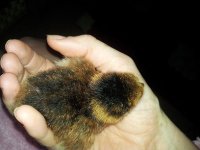So, I have just hatched 7 Welsummers.
1 died shortly after hatching (it hadnt even got out of the shell fully). I'm not sure if it was trampled, I read not to open the incubator until all the eggs were hatched and it was a bit cramped with all the shells and new chicks. Alternatively, it looks as though it may have been exhaustion, he/she didnt seem to recover after hatching. I'm hatching a second clutch shortly so if I did something wrong I'd appreciate feedback so that i dont repeat the mistake. I use the small Brinsea incubator with the automated turner, temp at 37.5, humidity increased in the last few days from one chamber filled to both chambers filled with water as per the instructions.
The other thing is, one looks completely different from the others. He/she is much darker brown head back and wings, has no stripes or triangle or eyeliner and has a white breast.
I got my eggs from a reputable breeder who I trust implicitly.
Is it possibly just a variation or is it more likely to be a mix up with the eggs.
I will post photos, I just want to give them time to recover. We have a weird narcolepsy / hypnosis thing going on at the moment where they are all chirping and moving around and then instantly at the same time they fall asleep lol . Waiting for them to be awake a little bit longer before I take photos.
1 died shortly after hatching (it hadnt even got out of the shell fully). I'm not sure if it was trampled, I read not to open the incubator until all the eggs were hatched and it was a bit cramped with all the shells and new chicks. Alternatively, it looks as though it may have been exhaustion, he/she didnt seem to recover after hatching. I'm hatching a second clutch shortly so if I did something wrong I'd appreciate feedback so that i dont repeat the mistake. I use the small Brinsea incubator with the automated turner, temp at 37.5, humidity increased in the last few days from one chamber filled to both chambers filled with water as per the instructions.
The other thing is, one looks completely different from the others. He/she is much darker brown head back and wings, has no stripes or triangle or eyeliner and has a white breast.
I got my eggs from a reputable breeder who I trust implicitly.
Is it possibly just a variation or is it more likely to be a mix up with the eggs.
I will post photos, I just want to give them time to recover. We have a weird narcolepsy / hypnosis thing going on at the moment where they are all chirping and moving around and then instantly at the same time they fall asleep lol . Waiting for them to be awake a little bit longer before I take photos.


